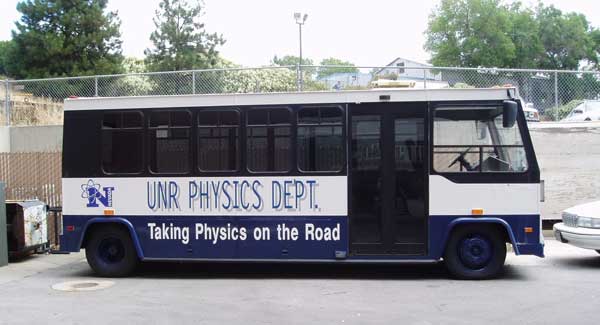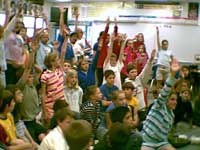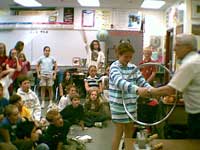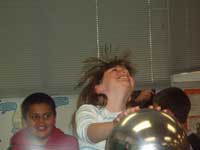Forum on
Education of The American Physical Society
Summer 2005 Newsletter
Physics on the Road at the University of Nevada, RenoDavid Bennum“It was a shocking experience!” “I really got a “bang” out of it!” “It just made my hair stand on end!” These are some of the comments I see regularly in thank-you notes from students whose classes I have entertained and educated with the University of Nevada Physics Department’s “Taking Physics on the Road” bus.
Throughout my career as a member of the physics faculty at UNR, I have actively sponsored “demo” shows at the campus for visiting elementary, middle and high school classes on field trips or university organized campus tours. Several years ago it became apparent that the number of such visits was declining as school budgets tightened and field trips were considered unaffordable by many schools. To continue what we considered a critical early exposure to physical science for students, the department embarked on a “traveling program”. I attended a workshop at Colorado State University sponsored jointly by the APS Forum on Education and the American Association of Physics Teachers (AAPT) which brought together directors of successful traveling programs and those aspiring to start new ones to encourage programs related to the “World Year of Physics”. We shared experiences and ideas for several days and saw the CSU “Little Shop of Physics” public open house. Several new demos have been added to our repertoire since that visit as well as a philosophy of increased hands-on experience by students. We acquired a retired experimental electric shuttle, painted it with logos, refurbished it a bit, and started taking demo shows and hands-on experiments to local schools. Since that time a newer, larger and more modern electric bus has been donated to the project by William Brinsmead, a departmental technician whose help in designing demos has been invaluable. He has a particular interest in electric vehicles and found a retired bus from San Diego that greatly increased the range and reliability of the transport. This newer bus uses a 360-volt Ni-Cd battery system and runs AC motors with a regenerative system. Several grants were awarded to programs such as UNR’s from the APS “Physics on the Road” and we were fortunate to be among the list of awardees. We are using the funds to add upgrades to the bus, increase its range and to buy and/or build demos for it that will make it more independent of the department’s resources. The demos we
use cover a broad range of physics concepts including mechanics (moment of inertia,
conservation of angular momentum, wave motion in one and two dimensions with large
amplitude vibrating string and Chladni plate, standing wave in air column with a “flame
wave tube”), light and optics with several laser demos and concave/convex mirrors,
thermal physics with liquid nitrogen, Sterling engines, thermo-electric motors, and
others. The largest number of demos, because of their spectacular nature, is in the area
of electricity and magnetism. The most popular are the Van de Graaff generator, a large
exploding wire apparatus which doubles as a dramatic Faraday’s law demo (crushing or
launching aluminum cans) and various other induction experiments, a Tesla coil, Jacob’s
ladder and several smaller occasional demos such as motor-generator pairs.
Demonstrations are presented to any class level requested including “dog and pony” wow shows for preschoolers through 2nd grade, and increasing degree of concepts discussions as age/grade level increases. We also always try to leave behind some explanation materials for teachers to help answer questions that arise after we are gone. During this ”Year of Physics” we will be setting up a web request page on our science outreach site which will allow teachers and school administrators (or scout leaders and others) to arrange and schedule bus visits to their group. Part of the grant funds from APS will likely be used to remodel the bus interior with addition of benches for “Exploratorium” type self guided demos and the addition of an awning to expand the area outside the bus. We envision this as adding science fair and public outreach events to the current classroom and assembly show mode currently used. The electric nature of the bus gives us plenty of power to run displays independent of outlets. The other part of the science outreach program that I have been actively promoting is astronomy viewing for schools and the public. Currently we take portable telescopes ranging in size up to a 14-inch aperture Schmidt-Cassegrain telescope with computer guidance to schools or other public access sites and do free viewings. We try to be sure that viewers understand what they are looking at and some details about the objects viewed. The bus will likely be used for this purpose also, though currently the transport is by private vehicles. Both of these programs have been staffed not only by me but a group of undergraduate and graduate physics and science education majors who have volunteered their time and talents. The college students report that they not only enjoy helping K-12 students appreciate and understand science but have learned from the experience themselves. Projects of this nature are “win-win” for everyone involved. David
Bennum is Professor of Physics and Vice-Chair at the University of Nevada, Reno. |



